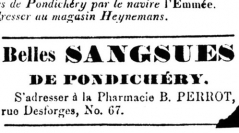

 Zoosystema
20 (3) - Pages 451-470
Zoosystema
20 (3) - Pages 451-470Medicinal leeches were not found in the West Indies prior to 1822, but by the turn of the century, a large, aggressive leech abounded on Puerto Rico, St Lucia, Martinique and other islands. The authors conclude that this "Caribbean leech", described as Hirudinaria (Poecilobdella) blanchardi Moore, 1901, is a junior synonym of the "buffalo" leech Hirudinaria manillensis (Lesson, 1842), the medicinal leech of India and neighbouring countries of South-East Asia. The final proof of the true identify of this West Indian leech came from comparison of the nucleotide sequences of the cDNAs of the hirudin polypeptide from leeches from St Lucia and from Bangladesh. The authors present evidence that this leech arrived from ships carrying labourers from colonial India starting in the mid-1840's. Each of these ships were required to have leeches on board for medicinal purposes. During this study, the existence of a second introduced leech species in the West Indies was unexpectedly discovered, in Guadeloupe. The question remains open whether this second species is the medicinal leech intentionally introduced into Guadeloupe from Senegal by the French for breeding purposes in the 1820's.
Hirudinea, Hirudinaria, hirudin, medicinal leech, medical history, West Indies.